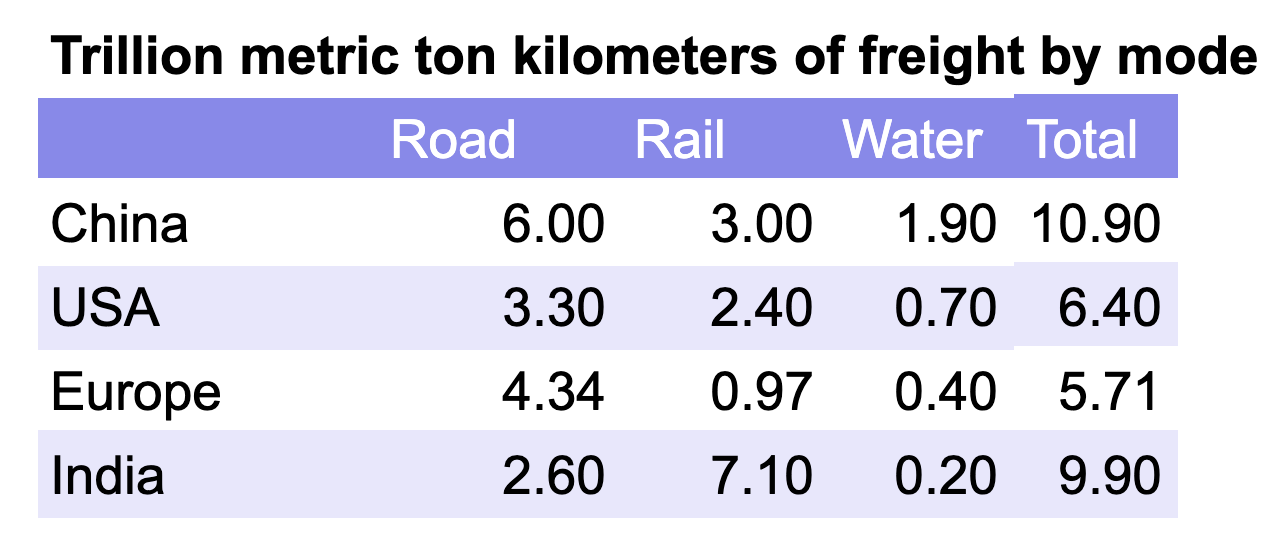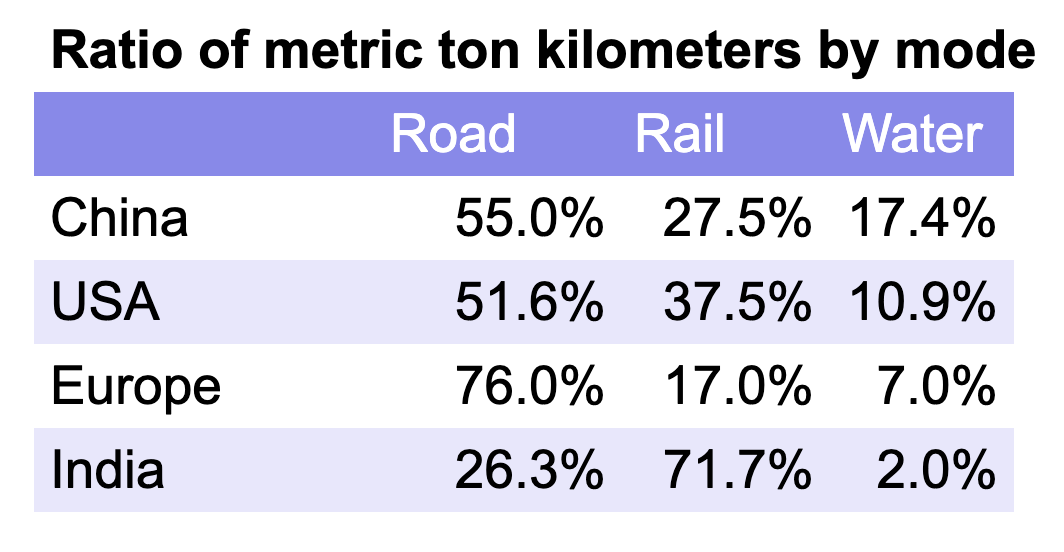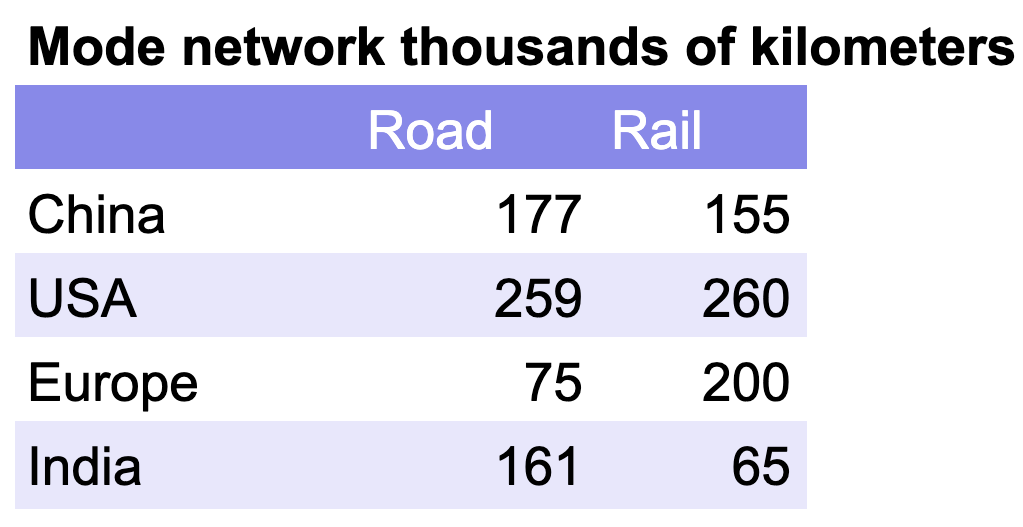Domestic Freight Mode Decarbonization Economics Will Vary Between Major Geographies
Sign up for daily news updates from CleanTechnica[1] on email. Or follow us on Google News[2]!
Every major geography will be electrifying virtually all domestic freight shipping in the coming two to three decades. However, the starting conditions matter between India, Europe, China, and the United States.
This assessment sprang out of a bit of news and discussion related to it today. China's Windrose Technology and its partners, including BorgWarner New Energy (Xiangyang) Co., Ltd, are now delivering a freight truck with a total weight of 49 tons -- all units metric -- including load. Per David Cebon, founder and director of the Centre for Sustainable Road Freight at Cambridge, that likely translates into 35 tons of capacity.
For context, Class 8 trucks in North America have a maximum weight of about 36 tons. The Chinese truck is big. The claimed range is 600 km fully loaded, but that's a claim from the firm without testing.
Actuals are to be determined. For comparison, the Tesla Semi has a claimed range of 800 km as a Class 8 truck with the weight exemption bringing its maximum loaded weight up to 37 tons. North American Council for Freight Efficiency testing in its Run on Less two-week data gathering exercise in September of 2023 found that it could actually do that under optimal conditions.
BorgWarner's contribution is blisteringly fast megawatt-scale charging. They've provided a liquid-cooled charger that can deliver 400 km of range in 36 minutes. Even if actual range is 500 km, charging that much that quickly can fit easily into operational schedules.
One of the threads of discussion I've been involved in at least peripherally is related to electrified road systems. That's putting wires over or power systems in roads to allow trucks to connect to them and power their motors from the grid with batteries. Cebon and his team have published a lot on the subject.
The Swedish-led European freight decarbonization study I assisted to a small extent within the past year, led by Jakob Rogstadius of RISE, included electrified road systems as an option. Cebon and Rogstadius' work shows that with current and even somewhat improved battery energy densities, costs, and charging time, the overall system cost of decarbonizing transportation is lower with electrified road systems. I'm more bullish on battery energy densities and costs and think that they'll win out for the most part, but this isn't to say that they aren't right.
I just think reality will be messier and more expensive rather than cost-optimized. The latest round of that discussion between Rogstadius, Cebon, and I occurred in the context of the very fast charging and very large Chinese battery-electric truck. It occurred to me to look at whether China had implemented any electrified road freight systems.
One of the filters I use to inform what is likely to work in other countries around decarbonization technologies is which ones have won in China and are being massively scaled. Wind, solar, and water are massively scaled compared to nuclear in China. There are about 1.2 million electric trucks and buses on China's roads, and a bit over 10,000 fuel cell vehicles, so clearly battery-electric is the winner domestically and so will likely be the winner globally.
Ditto heat pumps. While China builds at least one of everything and its firms will build whatever its customers want, it's what is scaled in China that's worth attending to. So is China building any electrified road systems?
No, it isn't. It has a couple of test facilities and some specific use cases, like tunnel servicing vehicles where diesel isn't viable, where they have put in overhead catenary systems. They have at least a few bus systems with en-route inductive charging, but it's unclear if that is dynamic charging -- operating while the bus is driving -- or static charging.
So there are electrified road systems tests in Europe, China, and even the United States, but no electrified freight highway systems. There are electrified trolley bus systems in various places, but not highway systems. And outside of the USA, overhead catenary power connections for freight and passenger trains are commonplace.
India is going to hit 100% heavy rail electrification this year. The last numbers I had for Europe and China were 60% and 72% respectively, but both were increasing. Dynamic power systems on linear freight systems are very well understood and applied outside of the USA, so their absence on roads is telling.
China certainly has some tailwinds for road freight electrification compared to the USA or Europe. Anything visible above ground level draws NIMBY complaints in the west, and especially in the USA the ability to say no to infrastructure has devolved down to the county and occasionally the individual level. China is much more able to build visible infrastructure without significant pushback from its citizens.
And China clearly has no problem building massive infrastructure projects. It has built 45,000 km of high-speed, grid-tied electrified rail since 2007. It has only been building highways since the mid-1980s and as you'll see, has built an awful lot of them in 40 years.
China also has no problem with electrifying transportation or building transmission and distribution networks. Its distribution grid is at least European standard, not the weak US mixture with frequently low voltages and wire numbers. Further, its distribution grid is very recent as well, built in many cases with electrification in mind.
Last, China is the world's biggest manufacturer and consumer of transformers, so the shortages of that key component that exist in North America and Europe aren't a hindrance. So if electrified road systems were such a slam dunk and China has such favorable conditions for them, why hasn't China deployed them? Is it just timing?
A specific question snagged my attention. I started to type an assumption I had about ratios of road freight vs water and rail in China versus other geographies. and realized it was just that, an assumption. So I rolled up my virtual sleeves and assembled a unified and normalized data set across China, Europe, the United States, and India to see if there were other factors that might be at play.
 Trillions of metric ton kilometers of domestic freight by major geography, chart assembled by author
Trillions of metric ton kilometers of domestic freight by major geography, chart assembled by author
A metric ton-kilometer (or a tonne-kilometer or of course a ton-mile in the USA) is a standard measure of freight tonnage, similar to passenger revenue kilometers (or miles in the USA of course) in aviation.
As you can see, all of these geographies are moving rather absurd tonnages of freight long distances every year, and all in the same total range of around 6 to 11 trillion ton kilometers annually. China, the USA, and Europe are also all around 10 million square kilometers, while India is about a third the size of any of them, which doesn't make it a remotely small country, being the seventh largest in the world. By the way, I assembled this data in an hour or so from something like 25 sources, normalizing everything into metric ton kilometers and finally learning how to turn the Indian crore unit into numbers I understand.
I'm not going to list all the sources, as I'm not doing a peer-reviewed paper, but they include Statista, India's rail organization, World Bank data, US Department of Transportation material, and even Wikipedia. It's an adequate first cut, not definitive. India's coastal shipping numbers are the biggest approximation, as I wasn't able to find a useful record of ton-kilometers or average shipping distances.
The country has increased coastal shipping substantially since 2000 as an intentional strategy due to its low carbon footprint and price, and is working on maximizing ports close to major onshore producers and consumers. Presently it is running around 300 million metric tons of freight annually in coastal waters and barely any on its network of 14,500 kilometers of inland waterways. I wasn't surprised that China had the highest domestic freight volumes, but was somewhat surprised they weren't higher.
It's possible that their intentional development of industrial hubs focused on different industries has shortened domestic supply chain distances substantially. Certainly when I looked at the global electric bicycle market[3] prior to COVID, there were strong geographical clusters. At present, a full third of China's e-bikes are built in one district of one city, the Xishan district of Kunming.
Foshan, foolishly, has chosen to develop the biggest fuel cell transportation industry in the world (still tiny), hoping to export to poorly informed western organizations, not realizing that the big governmental grants are going to be captured by highly connected locals. Among other things, this pattern allows firms to assemble a group of companies to work on larger orders, but also to have short distance and hence higher speed supply chains. I also wasn't surprised to see that China's water shipping was so much higher than every other major geography.
When I was building a global data set of inland, short sea, and deepwater shipping a couple of years ago so that I could do a scenario projection of maritime shipping decarbonization through 2100[4], China's major rivers and canals dominated the space globally. US domestic shipping has languished by comparison in recent decades as the Jones Act has strangled domestic ship building[5] and operations. I wasn't surprised that China's rail moved 50% of the mass of its road freight, or that combined rail and water were 45% of domestic shipping.
 Chip in a few dollars a month to help support independent cleantech coverage[6] that helps to accelerate the cleantech revolution! I was surprised that the USA's rail system moved as high a percentage of freight as it does. That, however, will be in significant decline in the coming years and decades for two simple reasons.
Chip in a few dollars a month to help support independent cleantech coverage[6] that helps to accelerate the cleantech revolution! I was surprised that the USA's rail system moved as high a percentage of freight as it does. That, however, will be in significant decline in the coming years and decades for two simple reasons.
The first is that 31.4% of US freight rail tonnage in 2018 was coal. That's all going away, and rapidly. The second is that the US rail industry is fighting electrification tooth and nail, and as such will have higher operations and maintenance costs, while trucking is simply going to electrify over the kicking and screaming of the organizing body.
Vastly lower tonnages per kilometer of track, higher costs, and cheaper trucking competition isn't a good position for the US rail system. Other geographies' rail systems also move a lot of coal, but are electrified and more diversified, so this is a continuum of impact with the USA at one end.
 Ratios of metric ton-kilometers by mode across geographies, chart by author
Ratios of metric ton-kilometers by mode across geographies, chart by author
The comparisons are easier to see by showing the ratios as percentages. Some numbers leap out.
I was very surprised that over three-quarters of European freight traveled by road, for example. The very low ratio of water freight in India and high rate of rail freight met my expectations. I was somewhat surprised that China's road freight was as high as it was, even higher than the USA's, despite the massive build-out of electrified rail.
One more question occurred to me. How big were the ground networks in each country?
 Road and rail kilometers by geography, chart assembled by author
Road and rail kilometers by geography, chart assembled by author
Additional interesting numbers. The USA having by far the longest road and rail networks is unsurprising.
The rail length is something I assessed when looking at global rail electrification ratios[7] last year, and the country is famous for its roads. Europe's inverse ratios of road and rail length to road and rail freight tonnage is notable, but it's a geography which prioritizes passenger transportation while the USA prioritizes freight. India has the other inversion, which is a much shorter rail network but much higher rail tonnage.
The sheer length of China's road system shouldn't have surprised me, but did. Given that the country didn't have any working highways until 1988, the sheer speed of road-building is aligned with the speed of everything else in the country. As Cebon pointed out to me, electrified road systems need about 3,000 trucks a day to be cost advantageous over 20 years.
What matters there is the tonnage of freight by road and the length of the road networks. It appears that Europe has by far the best ratio of tonnage per road kilometer for electrified road systems. Of course, this is a rough measure.
China's population and most industry are clustered in a broad expanse of the southeast, just as the United States is heaviest on the coasts. The density of the Pearl River Delta, with its roughly 86 million inhabitants in an area the size of Croatia, allows for a lot of electrified road systems, but the payoff is lower as well. When 86 million people and all of the commerce and industry lives in a location that's perhaps 200 kilometers north to south and 300 kilometers east to west, battery-electric vehicles with smaller batteries work incredibly well.
But that's only 6% of China's population, about the same as the New York metro area's ratio in the USA. There's still a lot of country outside of that. India's low freight trucking to long highway kilometers suggests it's a poor fit for electrified road systems.
It is, however, electrifying its freight rail at an astounding pace. In 2007 there were barely any electrified tracks and India has been electrifying thousands of kilometers a year in recent years. There are other factors at play.
India, China, and Europe have a greater propensity for acceptance of public infrastructure than the United States. They are more likely to electrify roads, in other words. China has not electrified its roads at all despite having every single advantage, but is also in a rail-building spree.
It's quite probable that instead of electrifying a road, it would maximize electrified freight rail beside the road, which is much more efficient. And China owns the world's battery supply and is increasingly owning its electric vehicle supply. It can export battery-electric trucks, but exporting electrified road systems is a much less likely proposition.
As noted, the country has a strong export strategy, so that will tend to favor longer range battery-electric trucks and charging systems for them. Europe has the greatest road freight density, it turns out, but also has a lot of entitled affluent people who don't want to see more aboveground wires. India is maximizing freight use of its rail system and coastal shipping, not its road system.
That said, indications are that the rail system is running at maximum capacity. This suggests that road freight might increase in coming decades. China, in addition to lots and lots of battery-electric trucks and grid-tied trains, is also rolling out battery-electric freight ships as well.
It launched a pair of 700 container ships to run 1,000-km routes along the Yangtze in 2023, the first of many, as it has committed to decarbonizing inland shipping in the next couple of decades. India's coastal and meager internal shipping are highly likely to be electrified in coming decades. All in all, electrified road systems make economic sense in a bunch of countries, especially European ones, but face strong headwinds compared to alternatives.
But as Cebon and I have discussed, getting juice to megawatt-scale chargers all over the place is non-trivial. It is much easier to do that in China or even Europe than in North America. India has built up its grid tremendously over the past 20 years as well, but while I've heard good things about its comparative robustness at present, I haven't done an assessment yet.
Electrified road systems make systemic economic and environmental sense, but pragmatically, they may never surface.
Have a tip for CleanTechnica? Want to advertise? Want to suggest a guest for our CleanTech Talk podcast? Contact us here[8].Latest CleanTechnica.TV Video
[embedded content] Advertisement CleanTechnica uses affiliate links.
Advertisement CleanTechnica uses affiliate links.
Share this story!
References
- ^ daily news updates from CleanTechnica (mailchi.mp)
- ^ follow us on Google News (news.google.com)
- ^ global electric bicycle market (cleantechnica.com)
- ^ shipping decarbonization through 2100 (cleantechnica.com)
- ^ strangled domestic ship building (cleantechnica.com)
- ^ help support independent cleantech coverage (cleantechnica.fundjournalism.org)
- ^ global rail electrification ratios (cleantechnica.com)
- ^ Contact us here (cleantechnica.com)
- ^ here (cleantechnica.com)